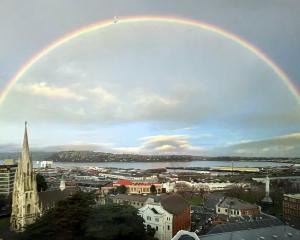Fear, fascination and food - creepy-crawlies play a bigger role in our emotional and physical world than we often recognise or care to admit. Bruce Munro talks invertebrates with Emma Burns, the curator of a bug exhibition at Otago Museum.
Her pug face is up against the inside of a large glass jar. Atop her small, bald head are two long antennae, protruding eyes and several short spikes.
Turned beige by seven and a half decades steeped in 70% alcohol, her bulbous, armoured body, six long, spindly legs and stunted, useless wings look positively extraterrestrial.
What is this unsightly, alien creature? The female Malayan jungle nymph is a not-so-stick-like stick insect. Up to 25cm long and several centimetres wide, it is one of the world's heaviest bugs.
But it is more than simply an exotic bug-eyed heavyweight. It is a representative of humanity's economic and environmental vulnerability and, well, what lunch could look like in about 20 years.
Bugs, invertebrates, creepy crawlies, insects, arthropods ... whatever we call them and however we classify them, it is time we get to know our smaller but much more populous neighbours, staff at Otago Museum reckon.
Globally there are an estimated 200 million bugs for every human, Emma Burns, who is a natural science curator at Otago Museum, says.
But our collective knowledge of the life cycle, habits and impact of bugs is confined to perhaps less than 4% of all the different species worldwide.
Which is a shame and a concern given their fascinating behaviours, their vital contribution to life on this planet, and the significant role they could soon be playing in our diet, Ms Burns says.
She is standing in a room full of insects. It is a collection preparation room that is behind locked doors, well away from the public spaces in Otago Museum. Fortunately the specimens here, or all the ones to be seen at any rate, are now more creepy than crawly.
There are display cases of dozens of insects a few millimetres to a few centimetres long, each pinned to its own mini death notice.
There are glass vials and jars of myriad shapes and sizes in which scores of rhinoceros beetles, the jungle nymph, specimens illustrating the various stages of a honey bee's life cycle, giant Californian water bugs, a Nelson cave spider ... all float in an endless sleep.
Some of the natural enemies of bugs, insectivores, are also gathered in the room. Stuffed and mounted, there are New Zealand natives such as the long-tailed cuckoo, kiwi, saddleback and mohua.
And from India, a pair of misnamed honey buzzards, which hunt wasps, not honey bees. Bugs are everywhere, Ms Burns says.
There are an estimated 10 quintillion (that is a 10 with 18 zeroes) bugs crawling, flying or swimming across the surface of the globe at any given moment.
New Zealand's bug population is comprised of an estimated 20,000 species, only half of which have been formally described.
Bugs have expanded into every habitat from the Antarctic (home to a flightless midge) to 5030m above sea level (where stoneflies were found on Mt Everest) and everywhere in between.
And while we and bugs share more in common than most people realise - 75% of the human genome is the same as that of the fruitfly - bugs have a fascinating, and sometimes terrifying, strangeness about them.
In some species, the juvenile is a completely different beast to the adult, Ms Burns says.
Ants, for example, hatch from eggs as maggot-like larvae before going through the transformative pupae stage to emerge as tiny, six-legged, workaholics.
In other cases, the male and female of the species have widely differing behaviours.
The New Zealand horse fly is a good example. The male feeds on nectar and pollen, while the female has a predilection for blood.
And then there are the downright bizarre bugs. Like the native New Zealand bat fly. Wingless and blind, it spends most of its life clinging to the bat's fur, feeding on bits of bat guano (poo) stuck in the fur.
It is on this tiny but weird and wonderful world of bugs that Otago Museum's newest exhibition focuses our attention.
''Bugs: the mega world of mini beasts'' opens today.
''Bugs get a bad rap in most people's minds,'' Ms Burns says.
''But they are fascinating on so many levels ... We hope that people will leave the exhibition with a new respect for their abilities, their place in our world, or their beauty.''
The exhibition draws on the museum's own collection, imported insects, and the talents of the likes of wildlife photographer Rod Morris and members of Otago Polytechnic's innovation workSpace to showcase this overlooked world, which accounts for 80% of the world's animal species.
In fact, there are too many bugs living in too many environments for the exhibition to do justice to them all.
So the organisers have focused their efforts on arthropods (animals with exoskeletons) including insects, arachnids (spiders, scorpions and their cousins), terrestrial crustaceans (such as wood lice) and myriapods (creepy-crawlies with lots of legs).
Themes within the exhibition help visitors explore what a bug is, how they have adapted to their environments, the interactions between bugs and humans, and some local scientific endeavours involving bugs.
Live displays include a dung beetle terrarium and a cockroach ''bug brother house''.
What are now called Gisborne cockroaches are thought to have slipped across the border aboard a ship from Australia in the 1950s. They are among three exotic and several native cockroach species now established in New Zealand.
These little beasties certainly are terrifyingly tenacious. But they also could be an alternative energy source.
Chop a cockroach's head off and its low blood pressure, breathing holes on its body, and decentralised nervous system will enable it to live, and continue spreading disease, for at least a week.
On the plus side, however, research in Tanzania, Africa, has shown the gut organisms of American cockroaches could be used to produce methane gas for heating and cooking.
New Zealand's 15 species of mostly forest dwelling native dung beetles are no match for the challenge presented by the burgeoning number of dairy farms.
So, several species of exotic dung beetles have been introduced to New Zealand to help aid the break down of cow pats.
An interactive display in the exhibition gives visitors the unique opportunity to discover whether they can push as much poo as a dung beetle.
The horned dung beetle that the interactive is based on can move 1141 times its own body weight - equivalent to an average person moving six double decker buses full of passengers.
There is also a giant interactive silkworm. People can pull the rope ''thread'' to see if they can produce silk as quickly as a silkworm. Bugs are fascinating, but they are also vital to our environment and economy, Ms Burns says.
''Without bugs, there are no humans,'' is her bold claim.
Bugs do a lot of free work for us, she says. If we did not have bugs we would have to clean up after ourselves. We would also have to pollinate all the vegetable crops we eat.
''There are about 100 types of crop plants which feed 90% of the world's population. Seventy percent of those plants are pollinated by bees alone. The cost of hand-pollinating crops would make the price of food exorbitant. But bees are doing this for us for free.''
Worryingly, bee populations worldwide are in decline. Scientists are still trying to understand why.
Ms Burns says the argument has been put forward that if there were no insects, there would be no humans.
''If all insects disappeared, they predict that we would go hungry within a couple of months. When humans go hungry, war can break out.''
Then, without insects to clean up all the mess caused by international conflict, the rapidly mounting risk of disease could lead to outbreaks of worldwide pandemics. But for bugs, the end is nigh.
And speaking of global catastrophes. Bugs could be our best hope of eating our way out of a looming food crisis, Ms Burns says.
It is estimated the global human population will reach nine billion sometime between 2035 and 2050.
A 2013 United Nations report examining the challenges that number of people will create is promoting bugs as a cheap way of producing high-protein food for lots of hungry mouths, both human and animal.
To highlight the issue, the exhibition includes samples of a variety of bug-based foods already commercially available.
Among the tasty treats with which we may become all too familiar are dehydrated, flavoured mixed bugs; giant waterbug chilli paste, two-bug kebabs; cricket protein bars; 100% cricket flour; ant egg seasoning sprinkles; moth larvae droppings in tea bags; and, for those with a sweet tooth, chocolate-coated silkworm pupae.











